中考专题-时态语态复习教案设计
《中考英语时态复习》教案
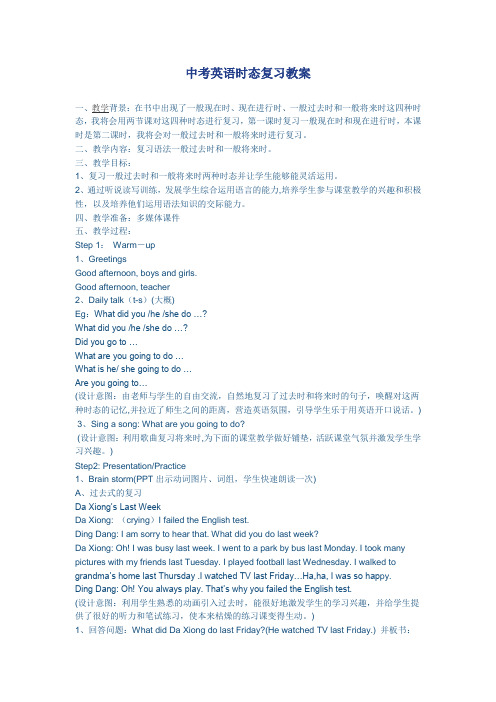
中考英语时态复习教案一、教学背景:在书中出现了一般现在时、现在进行时、一般过去时和一般将来时这四种时态,我将会用两节课对这四种时态进行复习,第一课时复习一般现在时和现在进行时,本课时是第二课时,我将会对一般过去时和一般将来时进行复习。
二、教学内容:复习语法一般过去时和一般将来时。
三、教学目标:1、复习一般过去时和一般将来时两种时态并让学生能够能灵活运用。
2、通过听说读写训练,发展学生综合运用语言的能力,培养学生参与课堂教学的兴趣和积极性,以及培养他们运用语法知识的交际能力。
四、教学准备:多媒体课件五、教学过程:Step 1:Warm-up1、GreetingsGood afternoon, boys and girls.Good afternoon, teacher2、Daily talk(t-s)(大概)Eg:What did you /he /she do …?What did you /he /she do …?Did you go to …What are you going to do …What is he/ she going to do …Are you going to…(设计意图:由老师与学生的自由交流,自然地复习了过去时和将来时的句子,唤醒对这两种时态的记忆,并拉近了师生之间的距离,营造英语氛围,引导学生乐于用英语开口说话。
)3、Sing a song: What are you going to do?(设计意图:利用歌曲复习将来时,为下面的课堂教学做好铺垫,活跃课堂气氛并激发学生学习兴趣。
)Step2: Presentation/Practice1、Brain storm(PPT出示动词图片、词组,学生快速朗读一次)A、过去式的复习Da Xiong’s Last WeekDa Xiong: (crying)I failed the English test.Ding Dang: I am sorry to hear that. What did you do last week?Da Xiong: Oh! I was busy last week. I went to a park by bus last Monday. I took many pictures with my friends last Tuesday. I played football last Wednesday. I walked to grandma’s home last Thursday .I watched TV last Friday…Ha,ha, I was so hap py.Ding Dang: Oh! You always play. That’s why you failed the English test.(设计意图:利用学生熟悉的动画引入过去时,能很好地激发学生的学习兴趣,并给学生提供了很好的听力和笔试练习,使本来枯燥的练习课变得生动。
中考时态复习教学案
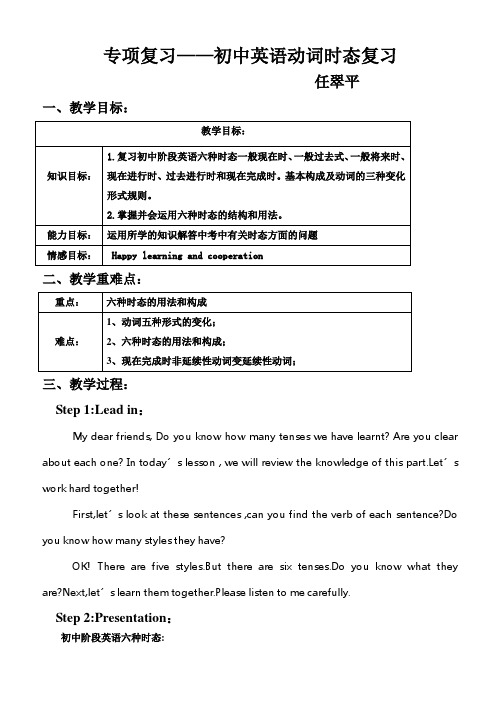
专项复习——初中英语动词时态复习任翠平一、教学目标:二、教学重难点:三、教学过程:Step 1:Lead in:My dear friends, Do you know how many tenses we have learnt? Are you clear about each one? In today’s lesson , we will review the knowledge of this part.Let’s work hard together!First,let’s look at these sentences ,can you find the verb of each sentence?Do you know how many styles they have?OK! There are five styles.But there are six tenses.Do you know what they are?Next,let’s learn them together.Please listen to me carefully.Step 2:Presentation:初中阶段英语六种时态:英语动词三种规则变化形式:1、现在完成时种一些常见的非延续性动词变延续性动词:①have arrived at/in sp.→have been in sp.②have joined/taken part in the army→have been a member of the army或have been in the army③have bought→have had④have died→______________⑤have left sp.→_____________________⑥have fallen asleep→have been asleep⑦have finished/ended/completed→_____________________⑧have married→have been married⑨have begun→______________⑩have borrowed→______________⑪have caught a cold→have had a cold2、用正确的动词时态填空①He ____(be) a student. I _____(be) a teacher now.②The children __________(dance) on the grass now.③She _______(study) at No.1 Middle School last term.④We _____________ (hand) in our papers already.⑤They ______(read) English every morning.⑥It’s 12 o’clock, she __________(have) lunch.⑦Do you know if he _________(come) back in an hour.⑧The boy ______(break) the glass just now.⑨_____you ever_____ (be) to Beijing?⑩There _______(be) a football match next week.四、作业布置:1、做一些时态综合练习题2、辨析have/has been to ,have/has gone to和have/has been in。
初中英语时态复习课教案

初中英语时态复习课教案1. 知识目标:(1)使学生掌握英语的八种时态:一般现在时、一般过去时、一般将来时、现在进行时、过去进行时、将来进行时、现在完成时和过去完成时。
(2)让学生了解每种时态的用法、构成和注意事项。
(3)培养学生运用各种时态进行交际的能力。
2. 能力目标:(1)能正确运用各种时态进行叙述和提问。
(2)能在具体语境中灵活运用各种时态。
3. 情感目标:(1)激发学生学习英语时态的兴趣。
(2)培养学生的团队协作精神。
二、教学重难点1. 教学重点:(1)英语的八种时态及其用法。
(2)各种时态的构成。
2. 教学难点:(1)过去进行时和将来进行时的用法。
(2)现在完成时和过去完成时的区别。
三、教学方法1. 采用情境教学法,通过设定各种生活场景,让学生在实际语境中学习时态。
2. 运用任务型教学法,让学生在完成任务的过程中运用所学时态。
3. 采用分组讨论法,培养学生的团队协作能力。
四、教学过程1. 导入(5分钟)通过一个简单的谜语游戏引入本课主题,激发学生的兴趣。
2. 知识讲解(10分钟)(1)一般现在时:描述经常发生的动作或存在的状态。
(2)一般过去时:描述过去发生的动作或存在的状态。
(3)一般将来时:描述将来会发生的动作或存在的状态。
(4)现在进行时:描述正在进行的动作或存在的状态。
(5)过去进行时:描述过去正在进行的动作。
(6)将来进行时:描述将来正在进行的动作。
(7)现在完成时:描述过去发生的动作对现在造成的影响或结果。
(8)过去完成时:描述过去发生的动作对过去造成的影响或结果。
3. 实例分析(10分钟)通过举例让学生了解各种时态的用法,并进行分组讨论。
4. 课堂练习(10分钟)设计一些练习题,让学生在课堂上完成,检验他们对时态的掌握程度。
5. 总结与反思(5分钟)让学生谈谈自己在课堂上所学到的知识,以及如何将这些知识运用到实际生活中。
6. 课后作业(课后自主完成)设计一些课后作业,让学生巩固所学时态。
中考专题-时态语态复习教案设计

2.表示客观事实、普遍真理或格言、谚语等。
The man who has never been to the Great Wallisnot a real man.不到长城非好汉。
如果句首有提示性动词look, listen等,主句也用现在进行时。
①Theyare watchingTV now.
他们现在正在看电视。
②Listen! The birdis singingin the tree.
听!鸟儿正在树上唱歌。
2.表示当前一段时间内的活动或现阶段一直进行的动作。
She is working in a factory.
2. --- Would you please show me your new i-watch?
--- Sorry, I ________ (type) a report and I will show it to you in a minute.
3. Humans ____________ (pollute) the earth all the time and there is not enough clean air and water.
5.现在完成时
用法
例句
1.表示说话之前已经完成了的动作,而且这个动作对现在仍有影响,常与already, yet, in the past few years等时间状语连用。
Ihave seenthe film already.
我已经看过这部电影了。(已知电影内容)
2.表示过去已经开始,持续到现在的动作或状态,常与by now, so far, since/for等时间状语连用。
中考英语时态复习教案
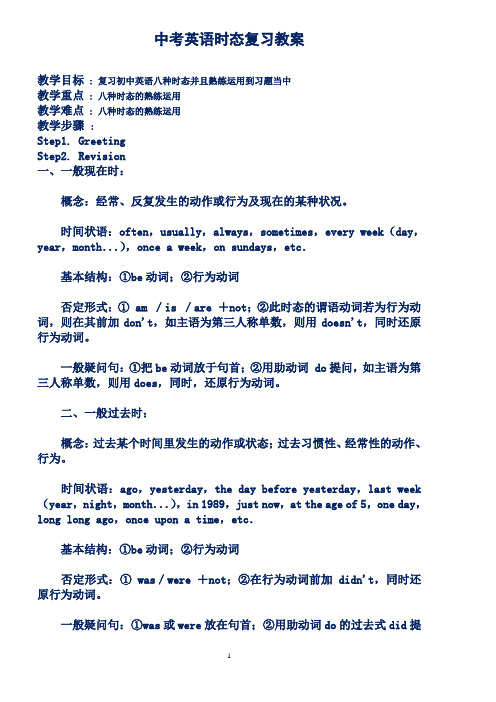
中考英语时态复习教案教学目标 : 复习初中英语八种时态并且熟练运用到习题当中教学重点 : 八种时态的熟练运用教学难点 : 八种时态的熟练运用教学步骤:Step1. GreetingStep2. Revision一、一般现在时:概念:经常、反复发生的动作或行为及现在的某种状况。
时间状语:often,usually,always,sometimes,every week(day,year,month...),once a week,on sundays,etc.基本结构:①be动词;②行为动词否定形式:① am /is /are +not;②此时态的谓语动词若为行为动词,则在其前加don't,如主语为第三人称单数,则用doesn't,同时还原行为动词。
一般疑问句:①把be动词放于句首;②用助动词 do提问,如主语为第三人称单数,则用does,同时,还原行为动词。
二、一般过去时:概念:过去某个时间里发生的动作或状态;过去习惯性、经常性的动作、行为。
时间状语:ago,yesterday,the day before yesterday,last week (year,night,month...),in 1989,just now,at the age of 5,one day,long long ago,once upon a time,etc.基本结构:①be动词;②行为动词否定形式:① was/were +not;②在行为动词前加didn't,同时还原行为动词。
一般疑问句:①was或were放在句首;②用助动词do的过去式did提问,同时还原行为动词。
三、现在进行时:概念:表示现阶段或说话时正在进行的动作及行为。
时间状语:now,at this time,these days,etc.基本结构:am/is/are +doing否定形式:am/is/are +not+doing一般疑问句:把be动词放在句首四、过去进行时:概念:表示过去某段时间或某一时刻正在发生或进行的行为或动作。
初中英语九年级动词时态专题复习教案(共5则范文)

初中英语九年级动词时态专题复习教案(共5则范文)第一篇:初中英语九年级动词时态专题复习教案(共)The Teaching Plan for Review of Tenses(1)任教学校:民勤县夹河中学授课教师:张玲授课年级:九年级授课时间:2016年4月25日Ⅰ.Teaching Aims and Demands:1.To revise the eight types of tenses that we've learned.2.Moral object: Practice makes perfect.Ⅱ.Teaching Key Points and Difficulties:1.The usages and forms of the tenses.pare different tensesⅢ.Teaching Aids:Multimedia and some cards.Ⅳ.T eaching Procedures:Step1.Greet the class.Step2.Lead-in.In this class, we'll review the eight types of tenses.Just now, we heard the song that is my favorite.Because it told us a love story that I was very impressed.In fact, many people and things have been touching us in the daily life.Today, I’d like you to follow me to feel these real moving stories.Please read these stories in your group, then finish these tasks ,Step3.Revise the usages of the tenses.Let student read three stories in materials in groups and then let them complete the tasks it given.Step4.Chant.Show the forms of each kind of tenses on the screen, play the music and chant with the whole class.Have them remember the forms.Chant Do does am is are Did was were Am/is /are doing Was/were doingWill/shall do and be going to Should/would do Have/has done And had done Step5.Practice.T ake the word work as an example, practice using the different forms of this word to fill in the blanks.1.He often works on the farm.2.He worked on the farm2 years ago.3.He is working on the farm now.4.He was working on the farm those years.5.He will work on the farm next year.6.He said he would work on the farm the next month.7.He has worked on the farm for three years.8.He said he had worked on the farm for 5 years.Step6.Do some exercises.Step7.Summary.In this class, we've revised the eight types of tenses about their usages and forms.We've also do some practice about them.But it is not enough, you should do more practice.Because practice makes perfect.Study hard and try your best.I believe you will make a great success in the Entrance Examination this year.Best wishes for you!Step8.Homework.At last I'll leave some homework for you.Write an article about yourself, tell us your past, your present and your future.第二篇:浅谈初中英语动词时态教学浅谈初中英语动词时态教学英语的动词时态这一语法现象与我们母语的语法差别较大,学起来也较乏味。
2023年中考英语复习五大时态复习教案

五大时态复习教案教学目标:1. 语言能力:使学生能够正确理解、掌握和运用五大时态。
2. 文化意识:使学生能够理解和辨别中英文在时态上的表达差异。
3. 思维品质:使学生能够通过对比分析、归纳总结的方式学习并掌握时态知识。
4. 学习能力:使学生能够通过时态学习,提高归纳演绎能力和自主学习能力。
教学重难点:教学重点:正确理解和辨析五大时态。
2.能够正确理解和区分中英文在时态上的表达差异。
教学难点:1.让学生正确理解和归纳内在和外在规律。
2.让学生在时态学习过程中提高归纳和演绎能力,提高自主学习能力。
教学过程:环节一课堂导入以学生熟悉的“小马过河”为主题,让学生回忆、复述和改写故事,并讨论其中可能出现的各种时态。
环节二呈现语言现象让学生正确使用五大时态,分组表达以下五个故事情节:1.小马的介绍——一般现在时态A little horse lives in the grassland with his mom...2.小马要过河——一般将来时态One day, he will cross a river to to bring something back...3.小马说经过——一般过去时态He tells his mom “I met Uncle Cattle, and he said the water was not deep...4.小马在过河——现在进行时态The little horse is standing in the water, and he finds that...5.小马过了河——现在完成时态He has crossed the river successfully...环节三总结语言规律让学生根据环节二的故事情节,总结各种时态之间的异同点,特别是谓语动词和时态标志词。
1.谓语动词总结2.动词变形总结3.时态标志词总结环节四时态练习五大时态专练各10题,5道基础题,5道提高题,详见试题。
中考英语专题复习 (一)时态和语态教案

have been (to)侧重指经历,表示曾经去过某地。(此时人很可能不在那里,已经回来)
have gone (to)表示某人已经去了某地。(此时人已在那里,或在路上,而不在这里)
4.现在完成进行时
⑮表示动作从过去一直持续到现在,可能刚刚结束,可能还在进行,而且还会进行下去。
表示感观的动词:look, seem, appear, taste, feel, sound等。
表示情感的动词:love, like, prefer, hate等。
表示思想、信念的动词:think (认为), consider (认为), believe, trust, guess, wonder, forget, know, understand, realize, suppose, agree等。
知识点2:过去时态
1.一般过去时
①表示过去某一具体时间发生的动作或存在的状态。常用的时间状语有:yesterday, last year, in 2012, the other day, in those days, during the night等。
②表示过去发生的经常、反复的动作或状态。
③表示实际上“刚刚”发生的动作,但没有表明发生的具体时间 。
3.现在完成时
⑩表示过去的动作或事情对现在的影响或结果,常用的时间状语有:recently, lately, before, yet, ever, never, once, just等。
⑪表示从过去某一时刻持续到现在的动作,这一动作还可能持续下去,常用的时间状语有:since, up till now, so far, for a long time, in the last/past few years, these days等。
初三中考英语语法专题复习之时态和语态讲义教案
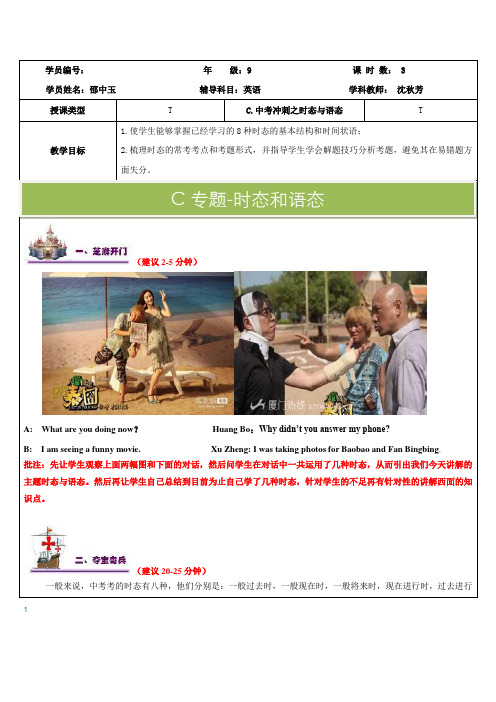
学员编号:年级:9 课时数: 3学员姓名:邵中玉辅导科目:英语学科教师:沈秋芳授课类型T C.中考冲刺之时态与语态T教学目标1.使学生能够掌握已经学习的8种时态的基本结构和时间状语;2.梳理时态的常考考点和考题形式,并指导学生学会解题技巧分析考题,避免其在易错题方面失分。
(建议2-5分钟)A: What are you doing now?Huang Bo:Why didn’t you answer my phone?B: I am seeing a funny movie. Xu Zheng: I was taking photos for Baobao and Fan Bingbing.批注:先让学生观察上面两幅图和下面的对话,然后问学生在对话中一共运用了几种时态,从而引出我们今天讲解的主题时态与语态。
然后再让学生自己总结到目前为止自己学了几种时态,针对学生的不足再有针对性的讲解西面的知识点。
(建议20-25分钟)一般来说,中考考的时态有八种,他们分别是:一般过去时,一般现在时,一般将来时,现在进行时,过去进行C专题-时态和语态1时,过去将来时,现在完成时和过去完成时。
被动语态考得相对简单,一般来说常考的有四种:一般过去时的被动语态,一般现在时的被动语态,一般将来时的被动语态和含有情态动词的被动语态。
时态和语态在考试中的出题形式常为:单项选择和改写句子。
要解答时态和语态方面的题目并不难,只要熟练掌握两点:1.每种时态常用的时间状语;2.每种时态的基本构成(包括肯定句,否定句和一般疑问句)。
下面我们将会通过解析一些典型的考题来体现这些技巧。
一、时态1. 一般过去时①时间状语:yesterday,the day before yesterday,last (week、month、year), ...ago,just now等;②基本结构:肯定句否定句疑问句Be动词I /She/he/it was ..adj/nWe/they/you were .adj/n I /She/he/it was ..adj/nWe/they/you were .adj/nWere you…Was she/he/it…Were you/they/you…实义动词(以do为例) I /She/he/it did…We/they/you did…I didn’t do…She/he/it didn’t do…We/they/you didn’t do …Did you do…Did she/he/it do…Did y ou/they/you do…【例题解析】Tina and her parents____________to England for sightseeing last summer.(2010上海中考真题)A) go B)went C) will go D)have gone批注:根据上面的讲解我们知道解题时首先要找时间状语,这道题目中的时间状语是“last summer”,由它我们可以判断出题目考查的是一般过去时,所以正确答案为B2.一般现在时①时间状语:always,“everyday,often,once a week(month,year),sometimes,seldom,usually等②主要用于下面几情况:1)描述当前时间内经常出现、反复发生的动作或存在的状态。
中考英语专项复习动词时态教学设计

中考英语专项复习动词时态教学设计教学目标:本节课的教学目标是让学生掌握一般将来时的用法和结构,能够正确运用一般将来时进行口头和书面表达。
过程:一、一般将来时:概念:表示将要发生的动作或状态。
时间状语:tomorrow。
next week (year。
month。
summer。
winter)。
in a few days。
soon。
later。
tonight。
this evening。
in the future基本结构:①will/shall+动词原形;②be going to+动词原形否定形式:will/shall+not+动词原形;be going to+not+动词原形一般疑问句:将will/shall/be going to放于句首,句末加问号。
XXX ________ go to Beijing next week。
(will)XXX ________ visit her XXX。
(be going to)二、现在进行时:概念:表示现在正在进行的动作或状态。
时间状语:now。
right now。
at present。
at the moment。
currently基本结构:be动词+动词ing否定形式:be动词+not+动词ing一般疑问句:将be动词放于句首,句末加问号。
XXX ________ swimming in the pool now。
(be)XXX ________ XXX(be)三、现在完成时:概念:表示过去发生的动作对现在造成的影响或结果。
时间状语:already。
yet。
just。
ever。
never。
before。
so far。
up to now基本结构:have/has+过去分词否定形式:have/has+not+过去分词一般疑问句:将have/has放于句首,句末加问号。
XXX ________ XXX(have)XXX ________ not visited the Great Wall yet。
初中复习课英语时态教案

初中复习课英语时态教案1. 知识与技能:(1)掌握四种基本时态(一般现在时、一般过去时、一般将来时、现在进行时)的构成和用法;(2)能够区分这四种时态,并在实际语境中运用;(3)了解时态的呼应原则,能在句子中正确运用相应的时态。
2. 过程与方法:(1)通过实例讲解,让学生理解时态的概念和意义;(2)通过小组讨论和练习,培养学生运用时态的能力;(3)运用多媒体手段,提高学生的学习兴趣和参与度。
3. 情感态度与价值观:(1)培养学生对英语时态学习的兴趣;(2)培养学生积极思考、主动探究的学习精神;(3)培养学生合作学习的能力,提高团队意识。
二、教学内容1. 教学重点:四种基本时态的构成和用法。
2. 教学难点:时态的区分和应用,特别是在实际语境中的运用。
三、教学过程1. 导入:(1)教师通过提问方式引导学生回顾已学过的时态知识;(2)学生分享对时态的理解和认识。
2. 讲解:(1)教师通过实例讲解四种基本时态的构成和用法;(2)学生跟随教师一起总结时态的规律;(3)教师强调时态的呼应原则,让学生明白在句子中如何正确运用相应的时态。
3. 练习:(1)学生分组进行练习,运用所学时态编写句子;(2)教师选取部分学生的练习进行点评和指导;(3)学生根据教师的反馈,修改自己的练习。
4. 拓展:(1)教师引导学生思考时态在实际生活中的应用;(2)学生分享自己的感悟和体验;(3)教师总结时态在生活中的重要性。
5. 总结:(1)教师带领学生回顾本节课所学内容;(2)学生自主总结时态的知识点;(3)教师布置作业,巩固所学知识。
四、教学评价1. 课堂参与度:观察学生在课堂上的发言和互动情况,评价学生的参与度;2. 练习完成情况:检查学生完成的练习,评价学生的学习效果;3. 课后作业:批改学生的课后作业,评价学生对课堂所学知识的掌握程度。
五、教学反思教师在课后要对课堂教学进行反思,分析教学过程中的优点和不足,针对性地调整教学策略,以提高教学效果。
中考英语专项复习——六种基本时态的教案
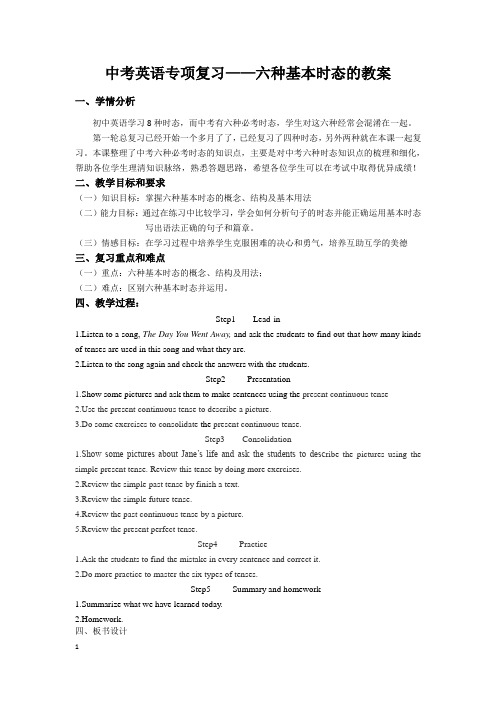
中考英语专项复习——六种基本时态的教案一、学情分析初中英语学习8种时态,而中考有六种必考时态,学生对这六种经常会混淆在一起。
第一轮总复习已经开始一个多月了了,已经复习了四种时态,另外两种就在本课一起复习。
本课整理了中考六种必考时态的知识点,主要是对中考六种时态知识点的梳理和细化,帮助各位学生理清知识脉络,熟悉答题思路,希望各位学生可以在考试中取得优异成绩!二、教学目标和要求(一)知识目标:掌握六种基本时态的概念、结构及基本用法(二)能力目标:通过在练习中比较学习,学会如何分析句子的时态并能正确运用基本时态写出语法正确的句子和篇章。
(三)情感目标:在学习过程中培养学生克服困难的决心和勇气,培养互助互学的美德三、复习重点和难点(一)重点:六种基本时态的概念、结构及用法;(二)难点:区别六种基本时态并运用。
四、教学过程:Step1 Lead-in1.Listen to a song, The Day You Went Away, and ask the students to find out that how many kinds of tenses are used in this song and what they are.2.Listen to the song again and check the answers with the students.Step2 Presentation1.Show some pictures and ask them to make sentences using the present continuous tensee the present continuous tense to describe a picture.3.Do some exercises to consolidate the present continuous tense.Step3 Consolidation1.Show some pictures about Jane’s life and ask the students to desc ribe the pictures using the simple present tense. Review this tense by doing more exercises.2.Review the simple past tense by finish a text.3.Review the simple future tense.4.Review the past continuous tense by a picture.5.Review the present perfect tense.Step4 Practice1.Ask the students to find the mistake in every sentence and correct it.2.Do more practice to master the six types of tenses.Step5 Summary and homework1.Summarize what we have learned today.2.Homework.四、板书设计中考英语专项复习——六种基本时态Class_________ Name______________ No._________一、学习目标和要求(一)掌握六种基本时态的概念、结构及基本用法(二)通过在练习中比较学习,学会如何分析句子的时态并能正确运用基本时态写出语法正确的句子和篇章。
人教版中考英语专题复习《时态专题复习》教学设计

人教版中考英语专题复习《时态专题复习》教学设计一. 教材分析人教版中考英语专题复习《时态专题复习》教材主要包括现在时、过去时、将来时和被动语态四大时态。
本节课旨在帮助学生系统地复习和掌握这四种时态的用法,提高他们的英语语法水平。
教材内容丰富,既有理论讲解,又有实例分析,还有练习题和测试题,旨在让学生在复习中不断提高。
二. 学情分析学生在小学和初中阶段已经学习了英语基础知识,对现在时、过去时、将来时和被动语态有一定的了解。
但部分学生对时态的掌握不够扎实,运用时态进行句子表达时仍存在一定的困难。
因此,在教学过程中,教师需要关注学生的个体差异,针对不同学生的学习需求进行有针对性的指导。
三. 教学目标1.知识目标:使学生掌握现在时、过去时、将来时和被动语态的构成、用法和辨析。
2.能力目标:提高学生运用时态进行句子表达的能力,增强他们的英语语法运用水平。
3.情感目标:激发学生学习英语的兴趣,培养他们积极向上的学习态度。
四. 教学重难点1.教学重点:现在时、过去时、将来时和被动语态的构成、用法和辨析。
2.教学难点:不同时态在实际语境中的运用和转换。
五. 教学方法采用任务型教学法、交际法和生活情境教学法,通过生动有趣的实例和实际语境,引导学生复习和巩固时态知识。
同时,运用小组合作、讨论和练习等方式,提高学生的参与度和积极性。
六. 教学准备1.教学课件:制作涵盖现在时、过去时、将来时和被动语态的教学课件。
2.教学素材:准备相关时态的例句、练习题和测试题。
3.教学设备:多媒体投影仪、音响设备等。
七. 教学过程1.导入(5分钟)利用多媒体展示不同时态的图片,引导学生猜测图片所表示的时态。
学生可以自由发言,教师总结并板书不同时态的关键词。
2.呈现(10分钟)教师通过PPT展示现在时、过去时、将来时和被动语态的构成、用法和辨析。
在呈现过程中,教师可以用简单的英语解释,同时配合中文翻译,以便学生更好地理解。
3.操练(15分钟)学生分组进行角色扮演,用所学的时态进行对话。
2024年中考英语时态语法专项复习教学设计
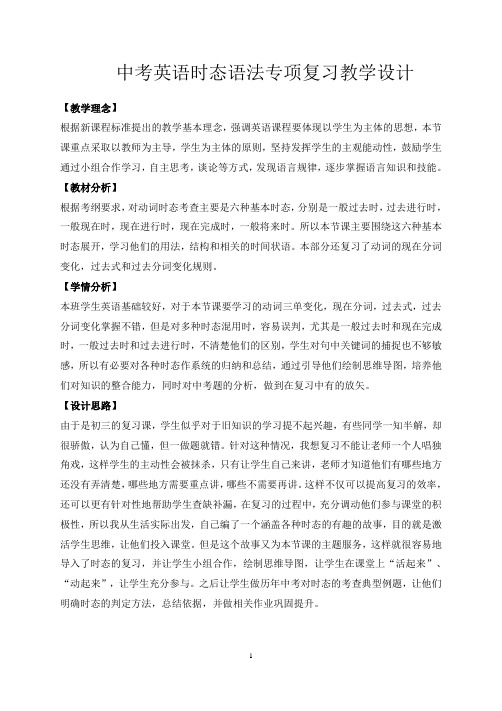
中考英语时态语法专项复习教学设计【教学理念】根据新课程标准提出的教学基本理念,强调英语课程要体现以学生为主体的思想,本节课重点采取以教师为主导,学生为主体的原则,坚持发挥学生的主观能动性,鼓励学生通过小组合作学习,自主思考,谈论等方式,发现语言规律,逐步掌握语言知识和技能。
【教材分析】根据考纲要求,对动词时态考查主要是六种基本时态,分别是一般过去时,过去进行时,一般现在时,现在进行时,现在完成时,一般将来时。
所以本节课主要围绕这六种基本时态展开,学习他们的用法,结构和相关的时间状语。
本部分还复习了动词的现在分词变化,过去式和过去分词变化规则。
【学情分析】本班学生英语基础较好,对于本节课要学习的动词三单变化,现在分词,过去式,过去分词变化掌握不错,但是对多种时态混用时,容易误判,尤其是一般过去时和现在完成时,一般过去时和过去进行时,不清楚他们的区别,学生对句中关键词的捕捉也不够敏感,所以有必要对各种时态作系统的归纳和总结,通过引导他们绘制思维导图,培养他们对知识的整合能力,同时对中考题的分析,做到在复习中有的放矢。
【设计思路】由于是初三的复习课,学生似乎对于旧知识的学习提不起兴趣,有些同学一知半解,却很骄傲,认为自己懂,但一做题就错。
针对这种情况,我想复习不能让老师一个人唱独角戏,这样学生的主动性会被抹杀,只有让学生自己来讲,老师才知道他们有哪些地方还没有弄清楚,哪些地方需要重点讲,哪些不需要再讲。
这样不仅可以提高复习的效率,还可以更有针对性地帮助学生查缺补漏,在复习的过程中,充分调动他们参与课堂的积极性,所以我从生活实际出发,自己编了一个涵盖各种时态的有趣的故事,目的就是激活学生思维,让他们投入课堂。
但是这个故事又为本节课的主题服务,这样就很容易地导入了时态的复习,并让学生小组合作,绘制思维导图,让学生在课堂上“活起来”、“动起来”,让学生充分参与。
之后让学生做历年中考对时态的考查典型例题,让他们明确时态的判定方法,总结依据,并做相关作业巩固提升。
初中英语时态和语态复习教案

初中英语时态和语态复习教案一、教学目标1. 熟练掌握英语的基本时态和语态;2. 能正确运用各种时态和语态进行句子转换;3. 加深对时态和语态的理解,提高英语语言运用能力。
二、教学内容时态和语态的复习和运用三、教学过程1. 导入通过展示一张图片或播放一个视频,引导学生回忆过去发生的事情,并让学生使用过去时描述图片或视频内容。
2. 时态的复习(1)现在时态- 用法:表示现在正在进行的动作或状态。
- 结构:主语 + 动词-ing- 例句:I am studying English now.(2)过去时态- 用法:表示过去发生的动作或状态。
- 结构:主语 + 动词过去式- 例句:He went to the park yesterday.(3)将来时态- 用法:表示将来要发生的动作或状态。
- 结构:主语 + will + 动词原形- 例句:They will have a meeting tomorrow.3. 时态转换练习让学生根据给出的句子,将其改写成其他时态,并解释改变的原因和规则。
例题:(1) They are playing basketball now.转换为过去时态:They were playing basketball yesterday.解释:由于动作是在过去发生的,所以需要将现在时态改为过去时态。
(2) I will go to the supermarket tomorrow.转换为现在进行时:I am going to the supermarket now.解释:虽然动作发生在将来,但是现在正在进行。
4. 语态的复习(1)被动语态- 用法:强调动作的承受者而非执行者。
- 结构:主语 + be + 过去分词(动词-ed)- 例句:The book was written by him.(2)进行时的被动语态- 用法:强调正在进行的被动动作。
- 结构:主语 + be + being + 过去分词(动词-ed)- 例句:The car is being repaired by the mechanic.(3)完成时的被动语态- 用法:强调动作已经完成的被动语态。
中考英语语法知识总复习教案
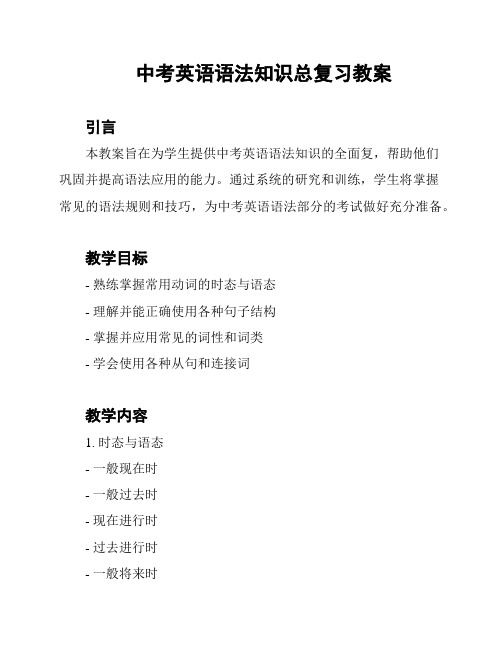
中考英语语法知识总复习教案引言本教案旨在为学生提供中考英语语法知识的全面复,帮助他们巩固并提高语法应用的能力。
通过系统的研究和训练,学生将掌握常见的语法规则和技巧,为中考英语语法部分的考试做好充分准备。
教学目标- 熟练掌握常用动词的时态与语态- 理解并能正确使用各种句子结构- 掌握并应用常见的词性和词类- 学会使用各种从句和连接词教学内容1. 时态与语态- 一般现在时- 一般过去时- 现在进行时- 过去进行时- 一般将来时- 一般过去将来时- 被动语态2. 句子结构- 主谓结构- 主语从句- 宾语从句- 同位语从句- 状语从句- 定语从句- 名词性从句3. 词性和词类- 名词- 代词- 形容词- 副词- 动词- 形容词和副词的比较级和最高级- 介词- 连词- 冠词4. 从句和连接词- 定语从句- 名词性从句- 状语从句- 连接词的使用教学方法1. 讲解法:通过讲解语法规则和例句来帮助学生理解和掌握知识点。
2. 练法:提供大量的练题和例句,让学生通过练巩固所学内容,并能够熟练应用到实际语境中。
3. 梳理法:总结复内容并归纳规律,帮助学生理清知识结构和逻辑关系。
教学评估教学过程中,可以通过课堂练、小测验和作业等方式来进行教学评估。
针对学生的不同程度和需求,可以采用个别辅导或小组合作研究的方式,培养学生的合作和交流能力。
教学资源- 教科书:提供适合中考英语语法知识的教材和练册。
- 视听资料:提供配套的录音材料和视觉教材,帮助学生更好地理解和运用语法知识。
教学安排本教案建议将语法知识复分为若干个单元,每个单元包括讲解、练和梳理三个部分。
每个单元的复时间可以根据实际情况进行调整,建议每周安排至少两个语法复课时。
结论通过本教案的研究和实践,相信学生们能够全面复中考英语语法知识,提高语法应用能力,为中考取得优异的成绩打下坚实的基础。
---以上是中考英语语法知识总复习教案的大致内容和安排,根据实际情况可以进行适当的修改和调整。
初中时态语态教案

初中时态语态教案一、教学目标1. 让学生掌握英语中的基本时态和语态,包括一般现在时、一般过去时、一般将来时、现在进行时、现在完成时、现在完成进行时、过去进行时、过去完成时、过去完成进行时。
2. 培养学生能够正确运用这些时态和语态表达过去、现在和将来的动作或状态。
3. 提高学生对英语时态和语态在实际语境中的运用能力。
二、教学内容1. 时态:一般现在时、一般过去时、一般将来时、现在进行时、现在完成时、现在完成进行时、过去进行时、过去完成时、过去完成进行时。
2. 语态:主动语态和被动语态。
三、教学方法1. 采用任务型教学法,通过小组合作、讨论等形式,让学生在实际语境中运用所学时态和语态。
2. 运用多媒体教学手段,如课件、视频等,直观地展示时态和语态的用法。
3. 采用互动式教学法,教师与学生充分交流,引导学生主动探究、发现和总结时态和语态的规律。
四、教学步骤1. 导入:通过一个发生在学校的故事,引出一般现在时、一般过去时和一般将来时的概念。
2. 新课:讲解一般现在时、一般过去时和一般将来时的用法,并通过例句和练习让学生熟练掌握。
3. 语态:讲解主动语态和被动语态的概念及用法,并通过例句和练习让学生掌握。
4. 实践:让学生分组讨论,运用所学时态和语态编写小故事,并进行展示。
5. 总结:教师引导学生总结本节课所学内容,强化记忆。
6. 作业:布置相关练习题,巩固所学知识。
五、教学评价1. 课堂参与度:观察学生在课堂上的发言和互动情况,评价学生的参与度。
2. 作业完成情况:检查学生作业的完成质量,评价学生对所学知识的掌握程度。
3. 小组讨论:评价学生在小组讨论中的表现,包括合作意识、创新能力和语言运用能力。
六、教学反思在课后,教师应认真反思本节课的教学效果,针对学生的实际情况,调整教学策略,以提高学生对英语时态和语态的掌握程度。
同时,关注学生的个体差异,给予不同程度的学生更多的关注和指导,确保教学质量。
(完整版)中考英语动词时态复习教学案
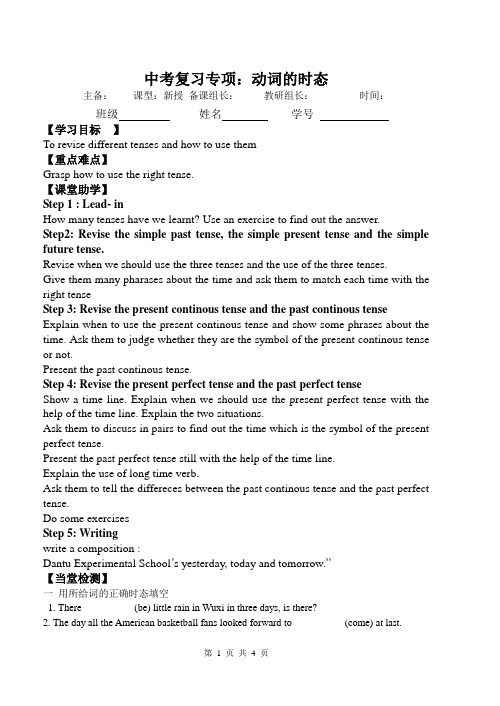
中考复习专项:动词的时态主备:课型:新授备课组长:教研组长:时间:班级姓名学号【学习目标】To revise different tenses and how to use them【重点难点】Grasp how to use the right tense.【课堂助学】Step 1 : Lead- inHow many tenses have we learnt? Use an exercise to find out the answer.Step2: Revise the simple past tense, the simple present tense and the simple future tense.Revise when we should use the three tenses and the use of the three tenses.Give them many pharases about the time and ask them to match each time with the right tenseStep 3: Revise the present continous tense and the past continous tense Explain when to use the present continous tense and show some phrases about the time. Ask them to judge whether they are the symbol of the present continous tense or not.Present the past continous tense.Step 4: Revise the present perfect tense and the past perfect tenseShow a time line. Explain when we should use the present perfect tense with the help of the time line. Explain the two situations.Ask them to discuss in pairs to find out the time which is the symbol of the present perfect tense.Present the past perfect tense still with the help of the time line.Explain the use of long time verb.Ask them to tell the differeces between the past continous tense and the past perfect tense.Do some exercisesStep 5: Writingwrite a composition :Dantu Experimental School’s yesterday, today and tomorrow.”【当堂检测】一用所给词的正确时态填空1. There __________(be) little rain in Wuxi in three days, is there?2. The day all the American basketball fans looked forward to __________(come) at last.3.---- It seems that you know a lot about the story.---- Well. We _____________ (read) it many times.4. Don’t wake up your father, if he __________(sleep) when you get home, will you?5. Boys and girls, please read the guidebook carefully, or you ______(get) lost during the visit.6. Fifty students have entered the writing competition since it ________(hold) for the first time.7.He promised us that she ____________ (tell) him about the event at the proper time, but actually(事实上) she didn’t.8. Before our teacher reminded us, we ______________ (send) the e-mails.9. —Please repeat what I said, Millie.—Sorry! I________(not listen).10. Our English teacher is happy because the rest of her students _____(pass) the exam as well. 二选择题1.I will tell him as soon as he _____ backA. comeB. comesC. will comeD. came2. Mary _____ on shoes when she ____ them.A. tries…buysB. tries… buiesC. trys… buysD. trys… buies3. The girl often ______ cold when she ______.A. cathcs…dancesB. catches… dancesC. catchs…danceesD. catches… dancee4. _____ he ____ himself there? No, I don't think so.A. Do…enjoyB. Does… enjoiesC. Does… enjoysD. Does…enjoy5. _____ your teacher ____ from them very often? Certainly.A. Do…hearB. Does…hearC. Do… receiveD. receive6. _____ your mother _____ some cleaning on Sundays?A. Does…doesB. Do…doesC. Does…doD. Do… do7. _____ Tom _____to work hard to help his family ? Yes, he _____.A. Has… x…doesB. Has…x…doesC. Does…has…hasD. Does… have…does8. Which teacher _____ lessons to you every day ?A. does …givesB. does… giveC. do… giveD. gives9. Smith does not go fishing on weekdays, ____? _____ , he does.A. does he…NoB. does he…YesC. doesn't he…NoD. doesn't he…Yes10.Mr Black often _____ fishing on Sundays, _____ he ?A. goes…doesn'tB. goes…isn'tC. doesn't go…doesD. doesn't go…is11.He usually _____ TV on Sunday evening.A. watchB. watchesC. watchingD. is watching12. We'll go to play with snow if it ______ tomorrow.A. snowB. snowsC. will snowD. snowed13. Neither I nor he ______ French.A. speakB. doesn't speakC. speaksD. doesn't speak14. Nobody ______ how to run this machines.A . know B. have known C. knows D. is knowing15. The Young Pioneer _____ water for the old man every day.A. carryB. bringC. takesD. carries16. Some are ______ in the river and some are ______ games.A. swimming… playingB. swimming…plaiingC. swimming… I playingD. swimming…plaing17. Look ! The boy students are _____ football while the girls are _____ .A. playing… danceB. playing… dancingC. play… dancingD. play… dance18. He _____ to do his lessons at eight every evening.A. is beginningB. is beginningC. beginD. begins19. _____ he _____ on well with his friends this term ?A. Does…getsB. Does…getC. Is…gettingD. Is…geting20. Mr Smith _____ short stories, but he ____ a TV play these days.A. is writing…is writingB. is writing… writesC. writes… is writingD. writes… writes21. I _____ to the cinema. I ______ there every Sunday.A. go…goB. am going… goC. go… am goingD. am going…am going22. Look, they______ a good time, ____ they ?A. have…doB. have…don'tC. are having…areD. are having… aren't23. You ______ about the future now, ______ you ?A. don't think…don'tB. aren't thinking… aren'tC. don't think… doD. aren't thinking… are24. She always ______ something whenever she ______.A .studied…played B. studied…plaiedC.. studied…plaiedD. studied… played25. He often _____ late in the forest. It _____ me very much.,A. stayed…worriedB. staied… worriedC. stayed…worryedD. staied… worried【课后巩固】1. I ______that the boy _____ with no tears in his eyes.A. noticed… cryedB. noticed… criedC. noticed…criedD. noticed… cryed2. We _____the floor and _____ all the windows.A. mopped… cleannedB. moped… cleanedC. mopped…cleanedD. moped… cleaned3. When I _____ the Children's Palace, the children _____ with joy.A. visited… jumppedB. visited… jumpedC. visited… jumpedD. visited… jumpped4. ______ a sports meet last Sunday ? Yes , they ______.A. Did they have… didB. Did they have… hadC. Had they... had D. Had they (i)5. ____ you _____out for a walk after supper ? Yes, I ______.A. Did…went…wentB. Did… go… wentC. Did... went... did D. Did... go (i)6. _____ Jack _____ on with his work or ______ to have a rest?A. Did… went… stoppedB. Did… go… stopC. Did… went… stopD. Did… go… stopped7. You gave them a talk two days ago, _____you ? Yes, I ______.A. did… didB. did… gaveC. didn't… didD. didn't… gave8. ____ your brother _____ a letter to ? My father.A. Who… wroteB. What…wroteC. Who did…writeD. What did… write9. They _____ about the TV news then in the sitting-room. They often ____ such talksA. talked…hadB. talk…haveC. were talking…hadD. are talking…have10. He ______ some cooking at that time, so _____ me.A. did… heardB. did… didn't hearC. was doing… heardD. was doing… didn't hear11. She ______ a book last year, but I’m not sure if she has finished it.A. is writingB. was writingC. wroteD. is writing12. This time yesterday Jack _____ his, bike. He _____ TV.A. repaired… didn't watchB. was repairing… watchedC. repaired… watchedD. was repairing… wasn't watching13. We _____ for Tom at ten last Sunday. He often kept us ______.A. were waiting… waitingB. were waiting… waitC. waited… waitingD. waited… wait14. When you _____ at the door, I _____ some washing.C. knocked… was doingD. knock… am doing【教学后记】。
2024年中考英语二轮专项复习教学案时态语态
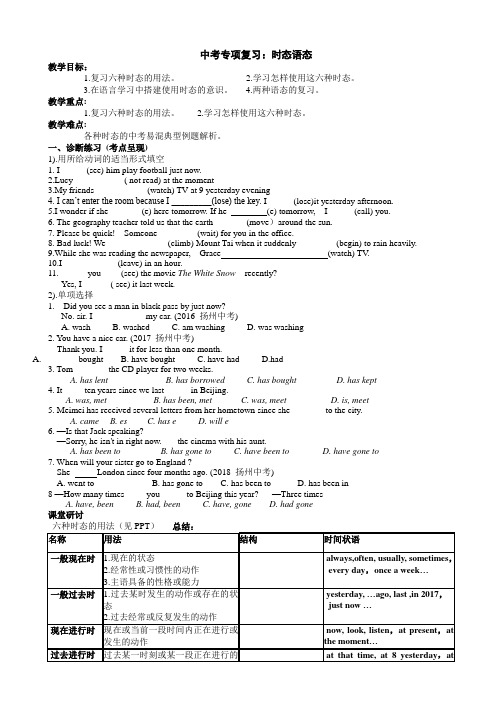
中考专项复习:时态语态教学目标:1.复习六种时态的用法。
2.学习怎样使用这六种时态。
3.在语言学习中搭建使用时态的意识。
4.两种语态的复习。
教学重点:1.复习六种时态的用法。
2.学习怎样使用这六种时态。
教学难点:各种时态的中考易混典型例题解析。
一、诊断练习(考点呈现)1).用所给动词的适当形式填空1. I _____ (see) him play football just now.2.Lucy ___________( not read) at the moment3.My friends ___________ (watch) TV at 9 yesterday evening4. I can’t enter the room because I _________(lose) the key. I _____ (lose)it yesterday afternoon.5.I wonder if she _______(e) here tomorrow. If he (e) tomorrow, I _____ (call) you.6. The geography teacher told us that the earth _______(move)around the sun.7. Please be quick! Someone ________ (wait) for you in the office.8. Bad luck! We _____________ (climb) Mount Tai when it suddenly ________ (begin) to rain heavily.9.While she was reading the newspaper, Grace (watch) TV.10.I____________ (leave) in an hour.11. ______you ____(see) the movie The White Snow recently?Yes, I ______( see) it last week.2).单项选择1. Did you see a man in black pass by just now?No. sir. I ___________ my car. (2016 扬州中考)A. washB. washedC. am washingD. was washing2. You have a nice car. (2017 扬州中考)Thank you. I _____ it for less than one month.A.boughtB. have boughtC. have hadD.had3. Tom _______ the CD player for two weeks.A. has lentB. has borrowedC. has boughtD. has kept4. It ____ ten years since we last _____ in Beijing.A. was, metB. has been, metC. was, meetD. is, meet5. Meimei has received several letters from her hometown since she _______ to the city.A. cameB. esC. has eD. will e6. —Is that Jack speaking?—Sorry, he isn't in right now. ___the cinema with his aunt.A. has been toB. has gone toC. have been toD. have gone to7. When will your sister go to England ?She London since four months ago. (2018 扬州中考)A. went toB. has gone toC. has been toD. has been in8 —How many times ____ you _____ to Beijing this year? —Three timesA. have, beenB. had, beenC. have, goneD. had gone课堂研讨1、一般现在时/现在进行时1)Mr. Smith __ short stories, but he __ a TV play these days.A. is writing, is writingB. is writing, writesC. writes, is writing2)Listen! This piece of music _______( sound) beautiful. I _________ ( listen) to it carefully.2.一般现在时/一般将来时1)I don’t know when he_________ (e) here tomorrow.When he______ (e) tomorrow, I _________(call)you.2) —Shall we go to the Sand Lake tomorrow?—Yes. We ______ (go) unless it _____ (rain) heavily.3)They ______( not play ) puter games until he ________ (finish) his homework this weekend.3、一般过去时和过去进行时1)While she ______(make) a phone call just now, I ______(play) puter games.2)As we _______(wait) for a bus yesterday, we _______(meet) her.3)He _______( sleep) when the telephone _______ (ring) an hour ago.4)I _________( write) a letter last night. I will go on writing toady.4、一般过去时/现在完成时1) I ________(eat) my breakfast this morning ,so I’m not hungry now. I _______(eat) bread and eggs.2) — I ________the film “Titanic”already.—When _____you ________it?(see)3). Your spoken English is so good. Have you been abroad?Yes. I _________ in America for three years and now I’m living in Beijing.A.will liveB.livedC.have livedD.was living三、中考链接1.Why are you so late today? Three buses went by without stopping while I at the bus stop.A.waitB. waitedC. am waitingD. was waiting2. I ______ you here, but you didn’t e.I’m terribly ill. I was so busy that I forgot.A.would expectB.was expectingC.am expectingD.have expected3.I will call you as soon as he ______ here.A.arriveB. will arriveC. arrivesD. arrived.4.—Do you know when Mrs. White ______ for dinner this evening?No, but I think she ________ when she is free.A.will e;will eB. will e;es C es; will e5.—May I use your puter? Sorry , I _________ on it.A.workB. am workingC. was workingD. have worked6.The bread is really delicious. Thank you .I _________ it myself.A.makeB. madeC. will makeD. am making.7.It has started to rain. It’s wise that we _____to the park.A.didn’t goB. aren’t goingC.don’t goD. haven’t gone8.When will A Bite of China III begin tonight? It _________ since ten minutes ago.A. beganB.has begunC. will be onD. has been on9.Andy with his parents _________ Hong Kong , and someshopping ________ by themA.have gone to; will doB.has gone to ; will be doneC. have been to ; will doD.has been to; do10. Can you go to the movies with me tonight?I have to ask my mum. If I _____, I will go with you.A.allowB. allowed.C. am allowedD. was allowed11. Who’s the little girl in the photo, LauraIt’s me. This photo _______ when I was five.A. is takenB. takesC. was taken.D.took二、语态:表示主语和谓语动词之间的关系。
- 1、下载文档前请自行甄别文档内容的完整性,平台不提供额外的编辑、内容补充、找答案等附加服务。
- 2、"仅部分预览"的文档,不可在线预览部分如存在完整性等问题,可反馈申请退款(可完整预览的文档不适用该条件!)。
- 3、如文档侵犯您的权益,请联系客服反馈,我们会尽快为您处理(人工客服工作时间:9:00-18:30)。
用法
例句
1.表示说话之前已经完成了的动作,而且这个动作对现在仍有影响,常与already, yet, in the past few years等时间状语连用。
Ihave seenthe film already.
我已经看过这部电影了。(已知电影内容)
2.表示过去已经开始,持续到现在的动作或状态,常与by now, so far, since/for等时间状语连用。
3. My mother told me that the earth _________ (travel) around the sun.
2.一般过去时
用法
例句
1.表示过去某个特定时间发生的动作或存在的状态。通常与yesterday, last year, in 1976, a few months ago等表示过去的时间状语连用。
【例题精讲】
一、填空:
1. --- One shouldn’t look down on others’ abilities, even a dog has its day.
--- I agree, you never know what __________ (happen) next.
2. I’m glad we ___________ ( visit ) the museum. I’m looking forward to the trip.
Imethim in the street yesterday.昨天我在街上遇到他了。
2.表示过去某一段时间内经常或反复发生的动作。通常与often, usually, seldom等表示频率的副词连用,但这种用法是以一个过去时间为前提的。
He oftenwentto school by bus last term.上学期他经常乘公共汽车去上学。
--For three years./ Since three years ago.
3)非延续性动词和延续性动词
非延续性动词
延续性动词
buy
have
borrow
keep
open
be open
close
be closed
begin/start
be on
come
be here
go
be there
员姓名:
辅导科目:英语
学科教师:
课程主题:中考专题-时态语态
授课时间:
学习目标
1.掌握六大时态以及注意点
2.掌握动词的语态及注意点
3.掌握中考动词时态和语态在中考中常见的考题和做题方法
教学内容
多元导入
互动精讲
一、时态
1.一般现在时
用 法
例 句
1.表示习惯性、经常性的动作或存在的状态,常与always, often, sometimes, every day等频率副词或时间状语连用。
5. My grandfather _______(shake) the bottle twice before he took the medicine.
3.一般将来时
用 法
例句
1.表示在将来某个时间将要发生的动作或存在的状态。常与tomorrow, soon, later, next time, in+一段时间等连用。
例:I have been in Nanjing for three years.
2) for和since的区别
(1)since的用法
A. since后可加时间点,如:Ithas beennine years since Ibeganto learn English.
B. since引导时间状语从句时,后面的时间状语从句动词用一般过去时,主句动词用现在完成时,如例句③。
I’ll starttomorrow.我明天动身。
2.“be going to +动词原形”用于表示主观上打算将来要做某事,这种打算往往是事先安排好的或表示可能要发生或肯定要发生的事情。
She has bought some cloth and sheis going to makeherself a dress.她买了一些布,准备为自己做一件连衣裙。
be over
die
be dead
join
be in/ be a member of
leave
be away from
arrive/reach
be here
get married
be married
4)一般过去时和现在完成时的区别
区 别
例 句
一般过去时表示过去某时发生的动作或单纯的叙述过去发生的事情,强调过去,与具体的表示过去的时间连用。
3. --- You may find the key to this math problem on Page 18.
--- Oh, it’s so easy. I wonder why I ________ (not think) of that.
4. When the famous scientist stayed in Paris, he ________ (choose) to make a living by drawing.
(4)表示归属的动词,如have(拥有), belong to等。
(5)表示思维,知识或理解能力的动词,如know, think (认为), forget等。
【例题精讲】
1. --May I talk to Jim?
-- Sorry, you can’t. He ___________ ( answer ) the phone.
Aliceisalwaysthinkingof others.
艾丽斯总是想着别人。
批注:
一般不能用于现在进行时的动词
(1)表示感觉的动词,如see, hear等。
(2)表示喜欢或厌恶的动词,如like, love, hate等;表示希望的动词,如want, would like等。
(3)表示状态的动词,如be, live, keep等。
(2) for的用法:for后加一段时间。如:They have worked in the factoryfor ten months.
(3) since和for用法的相互转换:for +一段时间= since+一段时间+ ago
(4)对since和for的提问用how long。
如:--How long have you been in Nanjing?
【例题精讲】
1. Tom ___________ (surf) online for games, so he pays little attention to his study every day.
2. I have a bad cold and my head ___________ (疼) a lot.
3. --Have you handed in your project?--No. I ___________ (check) it again right away.
4. The local government has promised they _______ (keep) rescuing survivors until all the missing people are found.
她正在一家工厂工作。
3.表示位置移动的动词,如come, go, leave, arrive等常用现在进行时表示最近即将发生的动作。
①I’m coming.我这就来。②Weare leavingtomorrow.我们将明天离开。
4.现在进行时与always, all the time等副词或短语连用常表示某种强烈的感情。
2. --- Would you please show me your new i-watch?
--- Sorry, I ________ (type) a report and I will show it to you in a minute.
3. Humans ____________ (pollute) the earth all the time and there is not enough clean air and water.
3.在时间、条件或让步状语从句中,表示将要发生的动作。
If itdoesn’t raintomorrow, I will leave.如果明天不下雨我将离开。
4. go, come, leave, arrive等瞬间动词常用一般现在时表示计划、安排好的将要发生的动作。
The train for Beijingleavesat 5: 30.开往北京的火车5: 30离开。
【例题精讲】
1. My father _________ (work) in a factory for five years. But now he is a teacher.
2. ---Is there any mistake in your homework, Jim?
---I’m not sure. I _____(not check) it carefully.
①I oftengoto school at seven.我经常在七点钟去上学。②WevisitUncle Liu every month.我们每月都去看望刘叔叔。
2.表示客观事实、普遍真理或格言、谚语等。
The man who has never been to the Great Wallisnot a real man.不到长城非好汉。
Ihave studiedin the school since 2009.
